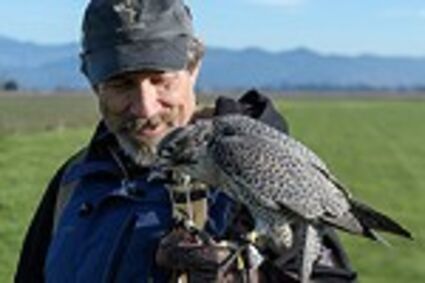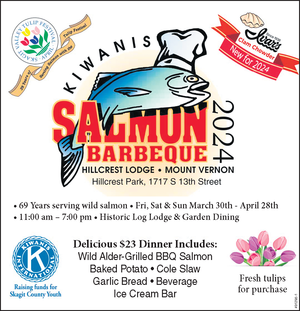The falconers among us
January 10, 2018

Brad Felger smiles at Titus, his peregrine falcon – gyrfalcon mix bird, after a successful lure stooping session. Titus eagerly devoured his meal after flying hard and fast and returning to the lure at Felger’s calling. Lure stooping is not only a way to exercise the birds, but is also often used as a bird abatement method, as birds scatter when they see the falcon flying. – Photo by Nancy Crowell
Local color –
You have probably heard the repetitive booming cannons and the recorded distress calls emanating from fields in the Skagit Valley during growing season. Those artificial warnings are designed to keep birds away from berries. Unfortunately, most birds get accustomed to the sounds after a few days and quickly realize there’s no real danger preventing them from gorging on the current crop. That’s where Brad Felger comes in. His business, Airstrike Bird Control, Inc., is a natural, non-lethal falconry-based bird abatement program. In other words, his company provides falconers and their birds to chase away the crop consumers.
The perpetual twinkle of Felger’s quick blue eyes is noticeably brighter when he talks about his birds. It’s clear he loves what he does. Felger has spent a lifetime building the business he now owns by combining a childhood hobby and some savvy observations about farming.
Airstrike – based on Fir Island – serves some of Skagit Valley’s largest berry farmers, but also covers crops across the state, as well as vineyards and crops in Oregon, Idaho and California. His wife, Sue Hanneman, is also a licensed falconer and works a recycling station in Seattle three days a week with her birds. The company also does food safety to keep away nuisance birds.
Bird abatement is different from falconry, although Felger does both and is president of the Washington Falconers Association. Bird abatement requires a special license, use of captive-bred birds only and the falcons used do not kill the problem birds – they simply scare them away. Falconry involves licensing for wild birds and a two-year apprenticeship for training and caring for them. Falconers have hunting licenses and use their birds to catch wild quarry such as ducks and rabbits in season.
During the height of berry season, Airstrike falconers are in the fields all day, seven days a week, flying their birds of prey. According to Felger, their presence has a cumulative effect. Starlings that stalk a particular field will begin to recognize a falconer’s truck and may leave as soon as he pulls in to the area, before he’s even gotten a bird out. It’s a modern application of an old sport.
Felger fell in love with birds as a pre-teen in California. His patient parents allowed him to pursue his passion and he was still learning to care for and train birds well into his twenties. Back in the ‘70s when Felger acquired his first hawk – bought in a pet store when pet stores still carried hawks – there were no licenses or regulations overseeing the capture or training of wild hawks. When that changed, he was one of the first to obtain a license to own a falcon.
In his 30 years as a professional farrier, he has always worked with birds of prey. During one serendipitous afternoon in the ‘90s he had a chance to fly his bird over a local vineyard. He noticed that the starlings who had been hovering near the vineyard and feeding on grapes took off as soon as his falcon took flight. It was the spark that lit an idea that led to a full-fledged business.
These days Felger is more involved in the management of his business – contracting with falconers to cover a wide variety of
accounts, breeding birds for other falconers and training future falconers. He would love to spend more time educating the public about the birds and what they do, and he’s continuously involved in various conservation efforts for wild birds.
One would never suspect the gray truck he drives is carrying precious cargo, but there are almost always birds in the back.
Although Felger doesn’t usually work the fields himself anymore – he contracts with somewhere between 20 to 25 licensed falconers for that – he still loves his birds and exercises them daily.
It comes with the territory.
Not as physically demanding as being a farrier, Felger still gets plenty of exercise as a falconer when he exercises his birds.
When he works a bird in a lure stooping session it’s as if he’s doing a highly choreographed dance.
The bird soars high in the sky then swoops down swiftly after the lure Felger swings round and round.
Falcons can reach speeds of up to 200 mph when in a deep dive.
The accuracy with which they strike is impressive.
Skagit Valley has always attracted an interesting mix of farmers, artists, and independent thinkers. A company that uses birds to keep the berries safe from other birds seems right at home here.
To learn more about the various services offered, visit: http://airstrikebirdcontrol.com/.









Reader Comments(0)